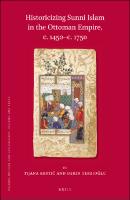Historicizing Sunni Islam in the Ottoman Empire, c. 1450-c. 1750
| dc.contributor.author | Krstić, Tijana | |
| dc.contributor.author | Terzioğlu, Derin | |
| dc.date.accessioned | 2020-10-13T12:29:17Z | |
| dc.date.available | 2020-10-13T12:29:17Z | |
| dc.date.issued | 2021 | |
| dc.identifier | ONIX_20201013_9789004440296_19 | |
| dc.identifier | OCN: 1250096529 | |
| dc.identifier.uri | https://library.oapen.org/handle/20.500.12657/42547 | |
| dc.description.abstract | Articles collected in Historicizing Sunni Islam in the Ottoman Empire, c. 1450–c. 1750 engage with the idea that “Sunnism” itself has a history and trace how particular Islamic genres – ranging from prayer manuals, heresiographies, creeds, hadith and fatwa collections, legal and theological treatises, and historiography to mosques and Sufi convents – developed and were reinterpreted in the Ottoman Empire between c. 1450 and c. 1750. The volume epitomizes the growing scholarly interest in historicizing Islamic discourses and practices of the post-classical era, which has heretofore been styled as a period of decline, reflecting critically on the concepts of ‘tradition’, ‘orthodoxy’ and ‘orthopraxy’ as they were conceived and debated in the context of building and maintaining the longest-lasting Muslim-ruled empire. Readership: All interested in the debates on Sunni Islam and in the politics of religion and confessionalism in the early modern Ottoman Empire and in “post-classical” Islamic history more generally. | |
| dc.language | English | |
| dc.relation.ispartofseries | Islamic History and Civilization | |
| dc.subject.classification | thema EDItEUR::N History and Archaeology::NH History::NHG Middle Eastern history | en_US |
| dc.subject.other | Middle Eastern history | |
| dc.title | Historicizing Sunni Islam in the Ottoman Empire, c. 1450-c. 1750 | |
| dc.type | book | |
| oapen.identifier.doi | 10.1163/9789004440296 | |
| oapen.relation.isPublishedBy | af16fd4b-42a1-46ed-82e8-c5e880252026 | |
| oapen.imprint | BRILL | |
| oapen.series.number | 177 | |
| oapen.pages | 546 |

